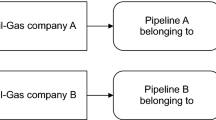Abstract
This paper examines a structural change in the natural gas industry that would lead to significant economies of cost and reliability, namely gas pooling arrangements among pipeline companies. In order that gas pooling he able to confer economic benefits, it must be practicable and workable. The study indicates that this is the situation. In addition, gas pooling confers substantial benefits on the participants. An analysis of spocific beneits is undertaken. These benefits are then compared with the disincentives to horizontal integration of the industry. The conclusion of the study is that thoughtful and consistent regulatory policies to encourage gas pooling are in the public interest.
Similar content being viewed by others
Selected References
W. Page Anderson, “Proposal to Treat Pipelines as Common Carriers,” Paper presented toInstitute of Public Utilities Conference, December 13–15, 1982.
Curtis A. Cramer, “Interconnection and Peak Responsibility in the Natural Gas Pipeline Industry,”Land Economics, Volume 44, pp. 229–34.
Curtis A. Cramer. “The Rate Structure of the Natural Gas Pipeline industry,Applied Economics, Volume 7, pp. 1–8.
Curtis A. Cramer and John Tschirhart, “Power Pooling: An Exercisc in Industrial Coordination,”Land Economics, February, 1983.
Alfred E. Kahn,The Economics of Regulation Volume 2, John Wiley and Sons, New York, 1971.
Natural Gas Pipeline Companies,Annual Reports. (Form 2) selected years, on file with the U. S. Federal Energy Regulatory Commission, Washington, D. C.
Natural Gas Pipeline Companies,Flow Charts, various winter heating seasons, on file with the U. S. Federal Energy Regulatory Commission, Washington, D.C.
Natural Gas Pipeline Companies,Transportation Tariffs, filed with U.S. Federal Regulatory Commission, Washington, D.C.
U.S. Federal Energy Regulatory Commission,Docket No. RM75-25, Order No. 2, February 1, 1984, Washington, D.C.
U.S. Federal Energy Regulatory Commission,Emergency Gas Pipeline Transportation with Computer Documentation. August 1978. Washington, D.C.
U.S. Federal Enorgy Regulatory Commission,Statistics of Interstate Natural Gas Pipeline Companies, 1975, 1979, 1980, Washington, D.C.
Wall Street Journal. “Texas OH & Gas, Midcon to By Pipeline System”, November 5, 1983.
Wall Street Journal, “Gas Consumers Say Pipelines Are Paying More Than Necessary for Their Supplies,” November 11, 1982.
Wall Street Journal, “Natural-Gas Industry Is in a ‘State of Flux’ As Pipelines Seek Cheaper Supplier Pacts,” June 14, 1983.
David W. Wilson, “Would a Form of Common Carrier Status for Pipelines Create a More Competitive Market?” Paper presented toInstitute of Public Utilities Conference, December 13–15, 1982.
Author information
Authors and Affiliations
Rights and permissions
About this article
Cite this article
Cramer, C.A. II Crizontal integration of the natural gas pipeline industry: An exercise in gas pooling. Rev Ind Organ 2, 68–78 (1985). https://doi.org/10.1007/BF02354367
Issue Date:
DOI: https://doi.org/10.1007/BF02354367




